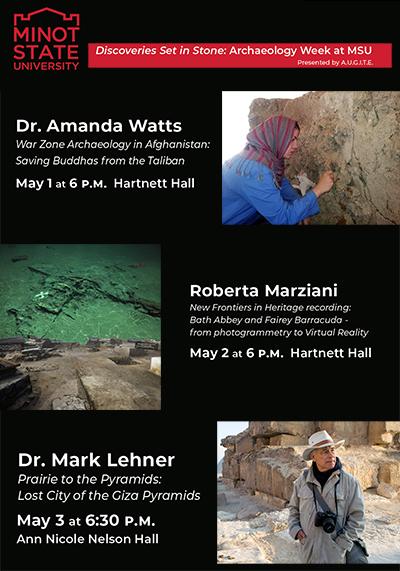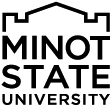Minot State to host ‘Discoveries Set in Stone’ archaeology event

MINOT, N.D. – Minot State University is pleased to announce Discoveries Set in Stone, a three-day archaeology conference featuring world-renowned Egyptologist and Minot native Mark Lehner, on May 1-3.
Discoveries Set in Stone is presented by the MSU Geology Club A.U.G.I.T.E. (Association of Undergraduate Geologists in Industry, Technology, and Education) as part of the Midcontinent Institute Geology and Geography Lecture Program. All sessions are free and open to the public.
“The Geology club began hosting professional speakers last year to share with students what kind of work is done off campus in town and abroad,” said Nikita Neyshtadt, president of MSU A.U.G.I.T.E. “We are excited to now open these lectures up to the general public to foster an interest in what is happening at the forefront of science. These lecture events are targeted for all ages."
Lehner will be the final presentation of the three-day Discoveries Set in Stone, with the lecture titled “Prairie to the Pyramids: Lost City of the Giza Pyramids,” scheduled for Friday, May 3 at 6:30 p.m. in Minot State’s Ann Nicole Nelson Hall. His talk will be preceded by a meet and greet in the lobby of Ann Nicole Nelson Hall in Old Main from 5-6 p.m. Lehner and the groundbreaking work his team at Ancient Egypt Research Associates (AERA) is doing will be featured in a National Geographic film “Lost Treasures of Egypt” that is scheduled to air from May 2 until July 2.

The event kicks off on Wednesday, May 1, with Minot State professor Amanda Watts's talk, “War Zone Archaeology in Afghanistan: Saving Buddhas from the Taliban,” in Hartnett Hall’s newly renovated Recital Hall, room 106, at 6 p.m. On Thursday, May 2, Roberta Marzianni will give a lecture, “New Frontiers in Heritage recording: Bath Abbey and Fairey Barracuda — from photogrammetry to Virtual Reality," starting at 6 p.m. in Hartnett 106.
“This is an exciting event for us — three world-class archaeologists talking about groundbreaking discoveries in far-flung parts of the world and giving these talks right here in Minot, North Dakota,” said Joseph Collette, MSU associate professor of geology. “We want to thank the generous support of the donor that made the Midcontinent Speaker Series possible! It's not every day that an event like this can happen. We would love to see as many folks from the community show up and take part in this awesome event as possible.”
Lehner is the president and co-founder of AERA and the director of the Giza Plateau Mapping Project. He has excavated in Egypt for more than 40 years, mapping the Great Sphinx and Giza Plateau and discovering the Lost City of the Giza Pyramids.

Lehner and AERA’s work was most recently featured on the cover of the New York Times and has been featured in National Geographic, Discover, Archaeology, New Yorker, Smithsonian articles, and documentaries by National Geographic’s Explorer, Discovery, BBC, and NOVA. AERA was featured in NOVA’s “Decoding the Great Pyramids,” which premiered on Feb. 6, 2019, and explored the discovery and translation of the oldest papyrus documents ever found, revealing new clues about the construction of Khufu’s Great Pyramid.
"Mark is a Minot native who last gave a lecture about his work in 2019,” Neyshtadt said. “He has since made astounding progress in the field, and we are really excited to hear from him. It will also be interesting to hear from both Amanda and Roberta as to what is happening at the very tip of the spear in the field of archaeology.”
As a field archaeologist, Watts has excavated on sites in the UK, USA, Turkey, Afghanistan, Rapa Nui, and Egypt. The art and objects of civilizations narrowed her specialism to material culture as an object’s conservator, first studying at University College London and then working in museum collections such as the Museum of London, the Petrie Museum of Egyptian Archaeology, Chedworth Roman Villa, the National Museum of Afghanistan in Kabul, and the Poe Museum of Richmond, Virginia.

Her primary research focuses on the ethical and rhetorical challenges of interpreting human remains and other material culture on museum display. More broadly, Watts finds new and dynamic ways to communicate cultural heritage to audiences through the study of art and material objects. As such, her research lends itself to the classroom where students in Art, Humanities, and English participate in cultural conversations about their own society as well as those of the past.
Marzianni works in the geomatics department in Salisbury, where she performs a diverse set of tasks, from technical support to field directing geomatics projects, including topographic surveys, laser scanning, photogrammetry, and 3D modeling of archaeological features and historical buildings.

About Minot State University
Minot State University is a public university dedicated to excellence in education, scholarship, and community engagement achieved through
rigorous academic experiences, active learning environments, commitment to public service, and a vibrant campus life.
Published: 04/04/24




